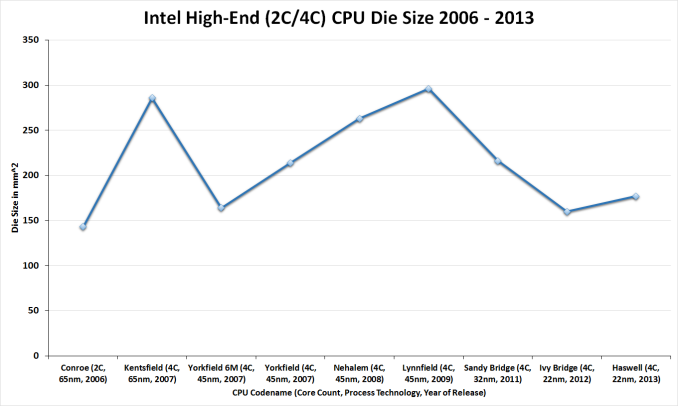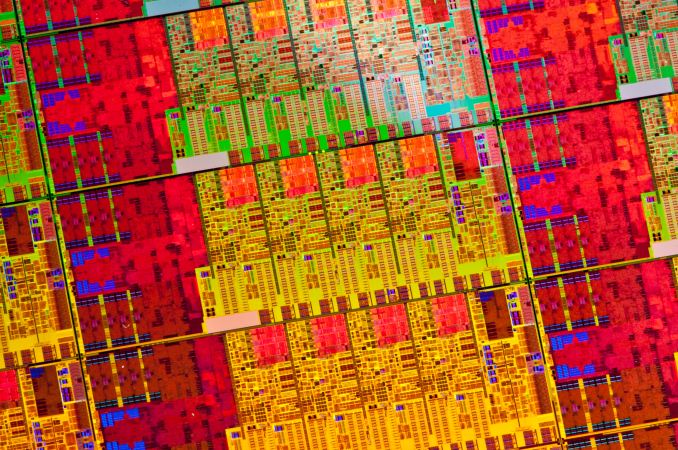The Haswell Review: Intel Core i7-4770K & i5-4670K Tested
by Anand Lal Shimpi on June 1, 2013 10:00 AM ESTDie Size and Transistor Count
Moving on to die sizes and transistor counts, this year Intel is striving to be more straightforward and accurate than was the case with Sandy Bridge and Ivy Bridge. With the Bridge generation we didn’t initially get comparable numbers, only for the correction to throw in additional confusion. For Haswell Intel is laying things out from the start, listing both possible numbers so that either can be compared.
| CPU Specification Comparison | |||||||||
| CPU | Manufacturing Process | Cores | GPU | Transistor Count (Schematic) | Die Size | ||||
| Haswell GT3 4C | 22nm | 4 | GT3 | ? | 264mm2 (est) | ||||
| Haswell GT2 4C | 22nm | 4 | GT2 | 1.4B | 177mm2 | ||||
| Haswell ULT GT3 2C | 22nm | 2 | GT3 | 1.3B | 181mm2 | ||||
| Intel Ivy Bridge 4C | 22nm | 4 | GT2 | 1.2B | 160mm2 | ||||
| Intel Sandy Bridge E 6C | 32nm | 6 | N/A | 2.27B | 435mm2 | ||||
| Intel Sandy Bridge 4C | 32nm | 4 | GT2 | 995M | 216mm2 | ||||
| Intel Lynnfield 4C | 45nm | 4 | N/A | 774M | 296mm2 | ||||
| AMD Trinity 4C | 32nm | 4 | 7660D | 1.303B | 246mm2 | ||||
| AMD Vishera 8C | 32nm | 8 | N/A | 1.2B | 315mm2 | ||||
The two numbers for the most common Haswell configuration, Haswell GT2 4C, are 1.4 billion schematic transistors and 1.6 billion layout transistors. Why and what is the difference? The former count is the number of transistors in the schematic (hence the name), and is generally the number we go by when quoting transistor counts. Meanwhile the second number, the layout number, is the number of transistors used in the fabrication process itself. The difference comes from the fact that while the schematic will use one large transistor – being a logical diagram – production will actually use multiple transistors laid out in parallel for layout and process reasons. So how many transistors does Haswell have? It has both 1.4B and 1.6B, depending on which number we’re after, with 1.4B being the number Intel is passing around.
In any case, even among quad cores Haswell is going to come in a couple of different sizes. Along with the 1.4B transistor, 177mm2 4C/GT2 version of Haswell, there is the 4C/GT3 version of Haswell, which Intel doesn’t list the die size or transistor count for. Based on our rough measurements of the physical die we’re at 264mm2, which including the epoxy covering the die will run a bit large.
Breaking things down to the GPU portion of Haswell, based in turn on these measurements I came up with an 87mm^2 adder for the extra hardware in Haswell GT3 vs. GT2. Doubling that 87mm^2 we get a rough idea of how big the full 40 EU Haswell GPU might be: 174mm^2. If my math is right, this means that in a quad-core Haswell GT3 die, around 65% of the die area is GPU. This is contrary to the ~33% in a quad-core Haswell GT2. I suspect a dual-core + GT3 design is at least half GPU. Meanwhile Crystalwell, the 128MB eDRAM, adds another 84mm2 die (by our measurements) to the entire package.
On a comparative basis, the 4C/GT2 version of Haswell is roughly 200M transistors and 17mm2 bigger than the comparable 4C/GT2 version of Ivy Bridge. The transistor count increase is roughly what we’d expect, with most of those transistors going to Haswell itself while the GPU remains relatively unchanged. Though it’s interesting to note that while this marks a 17% increase in transistors, it’s only an 11% increase in die size. Ivy Bridge was a small die for an Intel, and while Haswell grows larger in exchange for the additional functionality the new architecture provides, it’s still a fairly small GPU and reaches a density greater than Ivy Bridge itself. Or to put this another way, Intel’s last tock CPU, Sandy Bridge, was larger still by almost 40mm2. It’s only once we start adding the relatively big GT3 GPU, and not the CPU, that we see Intel go well above 200mm2.












210 Comments
View All Comments
eckre - Friday, June 14, 2013 - link
VERY disappointing CPU, if you disregard ALL of the fake synthetic benchmarks, and use only the real world ones, the gains over the 3770K are 0.03%, max 8.8% and average at about a 3% Improvement. 3%? Not worth it. Motherboard? Z87 was suppose to drop PCI but all the motherboards still have it and nothing outrageous. So basically lower power consumption, better on board video performance and no discernible improvement over the 3770K.i7Ahmed920D0 - Monday, June 24, 2013 - link
GOOD BYE 920 D0 Ill never forget you ! Your going to moms rig ! Helllllooooo 4670k with upto 40% better performance for 225 bucks !Yangorang - Thursday, June 27, 2013 - link
There are some rumors that the Haswell desktop processors run fairly hot - can you confirm this at all in your testing?calico-uk - Friday, July 12, 2013 - link
Face it, A consumers market, not a true imagine of technology evolution. Low power with high temps? Just doesn't ring true, unless the chip has been purposely ' Restricted ' with only one cause in mind sales and protection of future sales. In layman's terms Greedy bastards more concerned with markets and money and not the Desktop guy who's impressed with performance. Blame Mac, Windows 8. And your tiny fucking phone.James McGrath - Sunday, August 11, 2013 - link
This test is a little bias against the Core 2 duo I think. What they have done is essentially pitch the very top end on Intel's last 4 generations against a mid to low end core 2 duo. It would be more fair if that generation was represented by a qx9770 or even a Q9650.clyman - Wednesday, October 23, 2013 - link
I have been involved in computer hardware, software and programming since 1986. There has never been a more reliable processor than Intel, at any time. The current ones still have to be tested over time, but I would not buy one. If you put enough case fans with the inferior processors, they might last 2 or 3 years. With an Intel processor, even overclocked with no case fans, provided you used the intel chipset, nearly 100% of them kept running for 5 or more years. Without overclocking, I still don't know when they will die, since none have to my knowledge. I have built at least 100 computers and have only built a couple non intel ones. It was obvious right away how inferior they were to intel. Also, I love my i7 haswell on an asus z87-pro motherboard. There is no need to overclock, the processor and memory score 7.8 out of 7.9 on the windows scale and the onboard graphics scores a 6.8. Not bad ratings. Also, the CPU only uses 7 to 8 watts of power most of the time.numskulll - Tuesday, November 5, 2013 - link
I'm quite happy with my undervolted Athlon 620 and Radeon 4200 graphics. More computing power than I need 99% of the time, estimated tdp of about 55-60 watts (1% of use) and system idle of about 40w (80+% of use). And if I ever play games it takes a few seconds to bung in a suitable graphics card. I doubt it will go belly-up in the foreseeable future, but if it does it only cost £50 second-hand about 3 years ago and would be even less to buy now.duttasanjiv - Friday, November 14, 2014 - link
I am planning to get a new i5 4690 system for 1080p transcoding. I am not interested in GPU assisted transcoding. My focus is on QuickSync assisted transcoding. It is said that latest Quicksync is almost comparable to CPU based transcoding.It is annoying to see all sites compare only obsolate systems with a vague spec. (including AnandTech). Then, they omit any screenshots. Some are so weird thay put the video at youtube!! How can one compare the quality after youtube again transcoded it?
So far I am looking for a scientific, specific comparison on -
1) i5 4690 or atleast 4570 with CPU only & with QS
2) Screenshots in PNG
3) Specifying what settings were used? What QRF / what QCF? What speed presets - 'slow' or medium? What profile - high or main?. 'faster' or 'very fast' settings speed presets is worthless.
2) What is the source format - 1080i or 1080p? How long? What was the target size.
3) What QuickSync performance settings were used? I heard that haswell supports 7 performance vs quality settings. Also never found if QS supports any other parameters.
Merely mentioning FPS or time won't help.
I request you to pl. provide us with such an comprehensive comparison with will help many users like me, to settle all doubts for good. Thx so much in advance...
minitt - Sunday, December 7, 2014 - link
They dropped I5 750 and I7 920 from the gaming benchmark because both the processor will put up decent FPS which will take away most of the lime light from the haswell. A 4.0 ghz clocked i5 750 or i7 920 is still capable of keeping the modern GPUs running at 100% .I would be more than happy if someone can prove me wrong.Miller1331 - Tuesday, December 1, 2015 - link
I have the 4770k in my Desktop which is used primarily for high end music production and it eats up everything I have thrown at it thus far